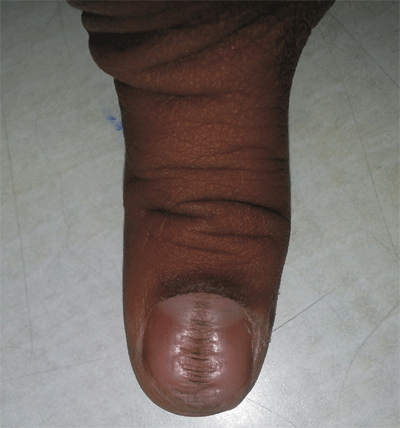A 5-year-old boy presented with single dystrophic thumb nail
since last seven months. Mother gave history of constant
biting of thumb nails. On examination, there was median
split of right thumb nail with transverse furrows extending
form longitudinal split (Fig. 1). All other
investigations were non-contributory. He was also diagnosed
to have attention deficit hyperactive disorder (ADHD).
 |
|
Fig.1 Dystrophic thumb nail
with medlan split.
|
Median canaliform dystrophy of Heller (solenonychina,
dystrophia unguis mediana canaliformis, nevus striatus
unguis) is an uncommon and rare dystrophic condition of nail
plate which usually affects thumb nails symmetrically and is
characterized by a midline defect of the nail plate leading
to longitudinal splitting in the midline with canal
formation. It extends from cuticle of nail and shows
transverse furrows extending laterally from longitudinal
splitting giving characteristic inverted fir tree
appearance. It may rarely involve toe nails and other finger
nails.
The proposed etiopathogenesis is repeated
self inflicted trauma in form of 2habitual nail biting. In
the majority of cases the cause is unknown and it may revert
back to normal after many months to years. Other proposed
that there is also absence of keratinocytes adhesions within
nail matrix with dyskeratosis which is responsible for
formation of longitudinal grove with splitting of nail plate
due to weaker tensile strength. There are some case reports
of median canaliform dystrophy of Heller after using
retinoids and with familial occurrence. Subungual tumors
like glomus tumor, myxoid tumors, papilloma, squamous cell
carcinoma, and melanoma may form longitudinal groove and
then splitting the nail plate in the middle portion leading
to median canaliform dystrophy.
The treatment includes avoidance of
repetitive nail trauma through behavioral counselling, and
topical tacrolimus.

